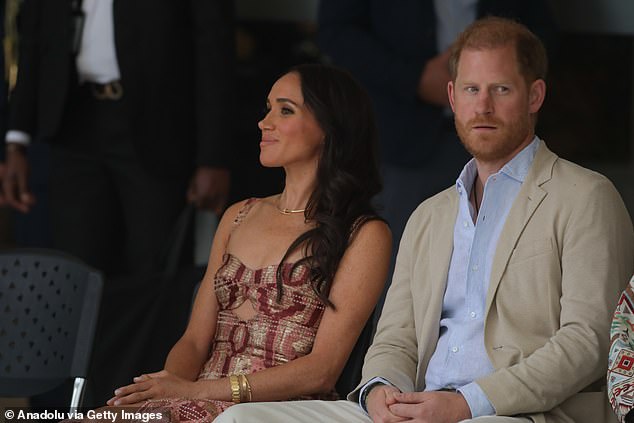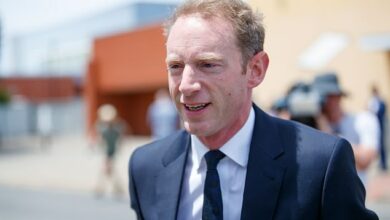JAN MOIR: Sorry Harry, this is why your do-goodery odyssey in the US has turned into a slow boil of utter cringe

Life begins at 40, as the saying goes. Yet as he approaches his milestone birthday next Sunday, Prince Harry has already done a lot of living. Perhaps even too much.
However, it is not his fault, as he often points out, that he has been in the public eye since birth. He didn’t ask to be born into the House of Windsor or paraded on the hospital steps when he was barely a day old; a little blueblood nugget of princely promise and aristocratic genes, swaddled in centuries of royal breeding.
Over the decades since, many different Harrys have floated across the world stage: adorable schoolboy in cap and piped blazer, tragic bereaved son, teenage tearaway, brave soldier, helicopter pilot, best man, worst option.

As his 40th birthday looms, Harry is described on his Archewell website as a ‘humanitarian, military veteran, mental health advocate, and environmental campaigner
Then there was Mahiki nightclub regular, husband and father, royal tormentor, exiled prince, self-appointed caped crusader.
It is no secret he has also been a joker, a smoker and a midnight toker. But these days, as he struggles to establish himself as an homme sérieux in America, Prince Harry likes to present his most solemn persona to the world.
As his 40th birthday looms, he is described on his Archewell website as a ‘humanitarian, military veteran, mental health advocate, and environmental campaigner’. Marvellous of course, especially for someone who left Eton with only two O-Levels.
Yet four years after he crossed the Atlantic to build a new life for himself and his family, how successful has Prince Harry’s US mission really been?
From some aspects, it is clear he has struggled to find a meaningful role and a personal brand that resonates with the American public. Perhaps he thought he’d go over there and enchant his way to the top with some good ol’ British charisma and polished vowels, while maximising his mother’s golden legacy and his wife’s glimmer of celebrity.
But that plan failed to land, while there have been many missteps and miscalculations along the way. Almost right from the start.
The whiny interviews, the mockery of the Royal Family, the couple setting themselves up as self-appointed experts who lecture us all on everything from mental health issues to climate change to world poverty.
‘Show up, do good’ is the mission statement on their Archewell website, which perfectly sums up the kind of self-congratulatory performative philanthropy at which the Duke and Duchess of Sussex excel. Who is that fooling? Nobody.
Recent Sussexian do-good international jaunts include giving laptops to impoverished children in Colombia and the Duchess telling impoverished children in Nigeria that ‘I see myself in all of you’.
When launching their online network for bereaved parents recently, Prince Harry waffled on incoherently about the dangers of the internet while the Duchess of Sussex told these shattered mothers and fathers that do you know what, she had suffered suicidal thoughts, too. Not forgetting the photoshoot in a Los Angeles military cemetery on Remembrance Day in 2020, which appalled many US veterans and no wonder; it takes a special kind of thoughtlessness to use a sacred site as a marketing opportunity.
Other low points have been Prince Harry accepting an award from John Travolta for being a Living Legend of Aviation, and telling an Apple documentary called The Me You Can’t See: ‘I’ve got a hell of a lot of my mum in me.’ On and on it goes, a slow boil of utter cringe.
That is not to say that Prince Harry does not mean well or deserve credit for some of his initiatives. The Invictus Games is certainly the best of him and has been a triumph around the globe. Yet as a pair of full-time activists, the Sussexes just don’t seem convincing or dedicated enough.
For a start, the sight of Prince Harry being eaten alive by his own piety as he or his wife climb aboard another private jet is hardly encouraging. And there is little transparency about money: how much they donate, how much they keep, who gets what and why.

His love and respect for his grandmother the Queen did not prevent Harry from causing her much trouble and worry in her old age
Their concerns about privacy are genuine, but you can take a personal quest for confidentiality too far. If they want people to believe in them, I believe they have to be more open.
Perhaps part of the problem is that in exile, Prince Harry has adopted the Royal Family model of patronages – of embracing multiple causes instead of focussing on one project where he could make a real difference.
The patronage system works in the UK because charities and organisations benefit hugely from the prestige of a royal imprimatur or interest – respect for the monarchy is naturally inbuilt in this country. The system is not so effective in a land where being royal is meaningless or carries less cachet. Harry is a prince in a republic, something he might do well to remember now and again.
And it doesn’t help that he now accepts awards rather than gives them out. That is not a good look for a royal.
One could argue that his unique and cloistered life experience as a royal has not equipped the
Duke for life in the boisterous meritocracy of America. He is a man who is so privileged he does not realise the depth of his privilege, remaining blind to the free pass that this privilege brings him.
On the infamous Oprah Winfrey interview in March 2021, the great moment that was supposed to be the Sussexes’ very own declaration of independence after ‘stepping back’ as royals, he detailed his grievances like a hawker laying out his trinkets on a blanket.
One of the chief beefs was money. ‘My family literally cut me off financially, and I had to afford security for us,’ he said, adding: ‘I’ve got what my mum left me, and without that we would not have been able to do this.’
He was 36 years old at the time, whining about a lack of funds from the Bank of Daddy while admitting that stashes of loot from the Bank of Mummy were all that was keeping him going.
Given that the concept of the self-made man is engrained in

Cheeky chappie Harry with his beloved mother Princess Diana at Trooping The Colour
the American Dream, many Americans must have looked askance at this grumbling Brit man-child with his inherited millions and wondered why they were being asked to sympathise.
Yes, Harry wanted to break free of his inherited social position, but he didn’t want to give up any of the advantages that came with it. He didn’t want to give up any of his royal titles or prestige.
He didn’t want to begin modestly and work his way back up in a way that might have earned him some respect. Never mind the rags, his great American reset was hard-launched on a strictly riches-to-riches trajectory. Prince Harry didn’t go to America to create a new identity for himself, he went there to replicate the old one.
So, four years on, where is he now? Certainly not in the important position of Prince Philanthropist he might have fondly imagined. He has little to zero political clout, not much veneration and a lack of public support from big hitters such as the
Obamas – people he once considered friends. The Sussexes had big hopes of being important, but does it amount to more than a hill of beans? Despite their best efforts, Harry and Meghan are not Amal and George and they’re not Barack and Michelle.
Increasingly and inescapably, perhaps even inevitably, the couple the Duke and Duchess of Sussex most resemble are Edward and Wallis Simpson. The former Duke and Duchess of Windsor were another pair of royals in exile who failed to find meaning and traction in their post-monarchy lives.
As Prince Harry faces another birthday and another year, what does the future hold? It can only get harder. As time goes on, the bloom fades on the rose and the cheeky charm that once endeared him to the world is rarely glimpsed these days. Often there is a touch of disdain in his blue-eyed gaze; sometimes he looks downright miserable. Perhaps he is thinking to himself, where did it all go wrong?
He launched his great charitable American adventure with much fanfare in 2020. Back then it was all about fixing the world and finding a cure for coronavirus; now it’s about jars of jam. Spread it around.
Life among men but shaped by women
Despite his military background and growing up with only a father and brother, Prince Harry is perhaps defined by the women in his life.
The late Queen Elizabeth, for a start. She was his much-loved ‘Gan-Gan, my granny, my commander-in-chief’; the tiny but powerful figure around whom his duties revolved for the first three decades of his life.
However, his love and respect for HM Gan-Gan did not prevent Harry from causing her so much trouble and worry in her old age. Nor has he been above tormenting another queen, publicly blaming Camilla for many of his woes when he was still an active member of the Royal Family.
There was his mother, Princess Diana, above all – the absence of whom has had such a continued and profound effect on his happiness.
Then there were the nannies, including Tiggy Legge-Bourke, the ‘favourite’ nanny who ‘blooded’ him after he killed his first animal (a rabbit) when still a boy. In his memoir Spare, he does not spare readers from embellishing the moment with a queasy erotic frisson. ‘ “Now”, she said in her throaty voice, “you are blooded,” ’ he writes.
Dear God. Sometimes it is not hard to see why Harry has been in therapy for much of his adult life.
Still, there was none of this sauce with Olga Powell, the no-nonsense nanny who would occasionally smack the naughty prince.
‘Harry, I love you, but I don’t like you’, she would tell him, when he was being particularly bad.
As he got older, there were all the beautiful girlfriends who blew in like petals on a summer breeze; all the Chelsys and the Cressidas and the Camillas and the Flos, few of whom lingered long.
There were the rumours, too, of flings with the Carolines, the Astrids and the Cassies, the showgirls and the lingerie models and the TV stars who moved in his orbit.
‘He had the pick of all the pretty women in the world,’ said actor Sir Ian McKellen recently. It is true.
Yet Harry still hadn’t found what he was looking for – until he met Meghan Markle in the summer of 2016. She did listen to Harry’s problems. And she went on to save him from a life he didn’t want to lead. There are those who believe the Duchess of
Sussex has been a pernicious influence on Prince Harry’s life. Yet there is another way of looking at it, which is that she was the making of him, giving his life a structure, a purpose, an escape route and the children he craved. He is the husband with all the medals on his chest, but perhaps she is the wife who really
Despite his military background and growing up with only a father and brother, Prince Harry is perhaps defined by the women in his life.
The late Queen Elizabeth, for a start. She was his much-loved ‘Gan-Gan, my granny, my commander-in-chief’; the tiny but powerful figure around whom his duties revolved for the first three decades of his life.
However, his love and respect for HM Gan-Gan did not prevent Harry from causing her so much trouble and worry in her old age. Nor has he been above tormenting another queen, publicly blaming Camilla for many of his woes when he was still an active member of the Royal Family.

As he got older, there were all the beautiful girlfriends who blew in like petals on a summer breeze, such as Chelsy Davy
There was his mother, Princess Diana, above all – the absence of whom has had such a continued and profound effect on his happiness.
Then there were the nannies, including Tiggy Legge-Bourke, the ‘favourite’ nanny who ‘blooded’ him after he killed his first animal (a rabbit) when still a boy. In his memoir Spare, he does not spare readers from embellishing the moment with a queasy erotic frisson. ‘ “Now”, she said in her throaty voice, “you are blooded,” ’ he writes.
Dear God. Sometimes it is not hard to see why Harry has been in therapy for much of his adult life.
Still, there was none of this sauce with Olga Powell, the no-nonsense nanny who would occasionally smack the naughty prince.
‘Harry, I love you, but I don’t like you’, she would tell him, when he was being particularly bad.
As he got older, there were all the beautiful girlfriends who blew in like petals on a summer breeze; all the Chelsys and the Cressidas and the Camillas and the Flos, few of whom lingered long.
There were the rumours, too, of flings with the Carolines, the Astrids and the Cassies, the showgirls and the lingerie models and the TV stars who moved in his orbit.
‘He had the pick of all the pretty women in the world,’ said actor Sir Ian McKellen recently. It is true.
Yet Harry still hadn’t found what he was looking for – until he met Meghan Markle in the summer of 2016. She did listen to Harry’s problems. And she went on to save him from a life he didn’t want to lead. There are those who believe the Duchess of
Sussex has been a pernicious influence on Prince Harry’s life. Yet there is another way of looking at it, which is that she was the making of him, giving his life a structure, a purpose, an escape route and the children he craved. He is the husband with all the medals on his chest, but perhaps she is the wife who really




